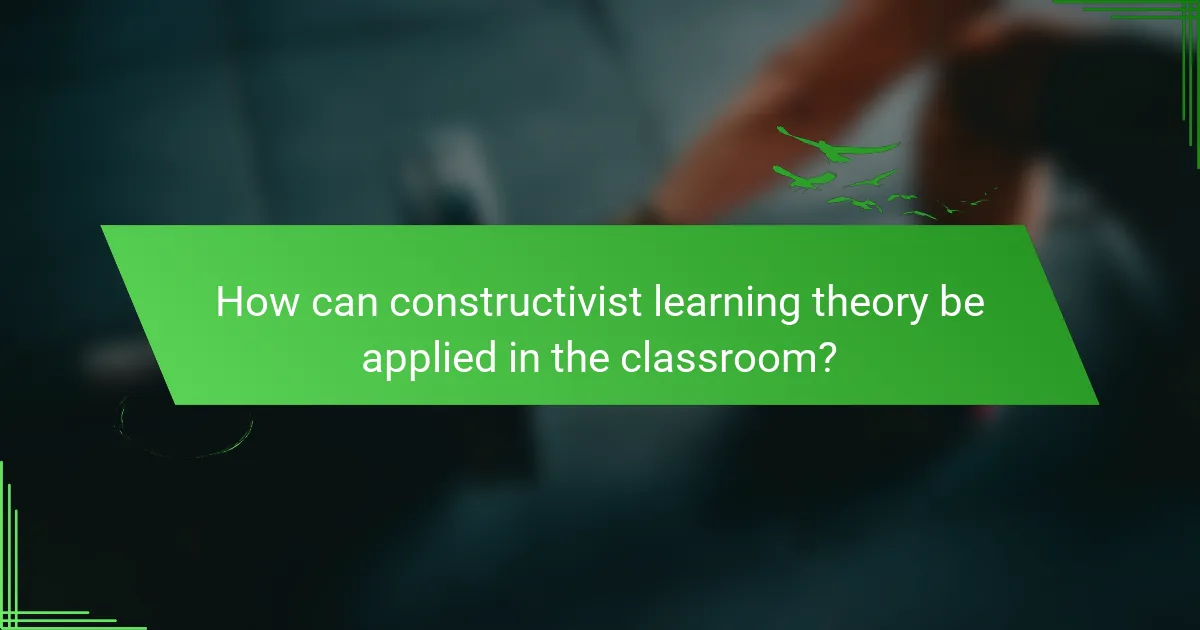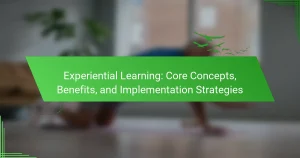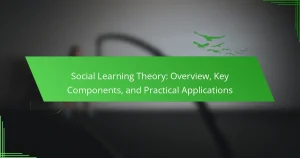Constructivist learning theory enhances student engagement and critical thinking by promoting active participation and collaboration. This article explores its key principles, highlights the benefits for learners, and discusses effective classroom applications. By integrating real-world problems and fostering reflection, educators can create a dynamic learning environment that caters to diverse needs.

What are the foundational principles of constructivist learning theory?
Constructivist learning theory is based on principles that emphasize active engagement and personal experience in the learning process. Key principles include learner-centered education, social interaction, and the importance of prior knowledge. Learners construct understanding through experiences, collaborating with peers, and reflecting on their learning. This approach fosters critical thinking and problem-solving skills, making education more relevant and meaningful.
How does active learning enhance understanding?
Active learning enhances understanding by engaging students in the learning process, fostering deeper comprehension and retention. It encourages critical thinking and problem-solving through hands-on activities and collaboration. This approach aligns with constructivist learning theory, which emphasizes that knowledge is constructed through experience. Active learning techniques, such as group discussions and interactive projects, promote active participation, making learning more relevant and meaningful. As a result, students are more likely to apply what they learn in real-world contexts, leading to better educational outcomes.
What role does social interaction play in learning?
Social interaction is crucial in learning as it enhances understanding and retention. Constructivist learning theory emphasizes that knowledge is constructed through social experiences. Interaction allows learners to share perspectives, challenge ideas, and collaborate, creating a deeper comprehension of concepts. Engaging with peers fosters critical thinking and problem-solving skills, essential for effective learning.
What are the stages of collaborative learning?
Collaborative learning involves several key stages: planning, executing, reflecting, and evaluating. In the planning stage, learners identify objectives and form groups. During execution, they engage in discussions and share knowledge. Reflection allows participants to assess their learning experiences. Finally, evaluation measures the outcomes and effectiveness of the collaborative efforts.
How does prior knowledge influence new learning?
Prior knowledge significantly enhances new learning by providing a framework for understanding. It allows learners to connect new information to existing mental models, making retention and comprehension easier. In constructivist learning theory, this principle emphasizes active engagement where students build on their previous experiences.
When learners relate new concepts to familiar ones, they can integrate information more effectively. For instance, if a student understands basic algebra, they can grasp more complex mathematical ideas by linking them to prior knowledge. This connection fosters deeper learning and critical thinking skills.
Additionally, prior knowledge can influence motivation and self-efficacy. When students feel confident in their existing knowledge, they are more likely to engage with new material and persist through challenges. This intrinsic motivation is vital for a successful learning environment, as it encourages exploration and inquiry.
In classroom applications, educators can assess students’ prior knowledge through discussions or surveys. This assessment helps tailor instruction to meet learners’ needs, ensuring that lessons build on what students already know. By recognizing and leveraging prior knowledge, teachers can create a more effective and personalized learning experience.

What are the key benefits of constructivist learning theory?
Constructivist learning theory enhances student engagement, critical thinking, and retention of knowledge. It promotes active participation, allowing learners to construct understanding through experiences. This approach fosters collaboration among peers, encouraging diverse perspectives and deeper comprehension. Additionally, it supports personalized learning, catering to individual needs and learning styles, resulting in improved academic outcomes.
How does it promote critical thinking skills?
Constructivist learning theory promotes critical thinking skills by encouraging active engagement and problem-solving. Learners analyze, synthesize, and evaluate information through collaborative activities. This approach fosters deeper understanding and the ability to apply knowledge in real-world contexts. As a result, students develop essential critical thinking skills, enabling them to question assumptions and explore diverse perspectives.
What impact does it have on student motivation?
Constructivist learning theory significantly enhances student motivation by fostering active engagement and personal relevance in learning. This approach encourages students to construct their understanding, promoting intrinsic motivation. When learners are involved in problem-solving and critical thinking, they feel a sense of ownership over their education. Research indicates that students in constructivist environments exhibit higher levels of motivation and persistence. By connecting new knowledge to prior experiences, students find learning more meaningful, which further boosts their motivation to explore and succeed academically.
How does it cater to diverse learning styles?
Constructivist learning theory caters to diverse learning styles by promoting active engagement and individualized learning experiences. It encourages learners to construct knowledge through hands-on activities, collaboration, and reflection. This approach supports visual, auditory, and kinesthetic learners by integrating various teaching methods such as group discussions, multimedia resources, and practical applications. By addressing different styles, it enhances retention and understanding, fostering a more inclusive learning environment.

What unique attributes differentiate constructivist learning from traditional methods?
Constructivist learning emphasizes active engagement and personal meaning-making, while traditional methods focus on rote memorization and passive reception of information. Key unique attributes include learner autonomy, collaborative learning, and real-world problem-solving in constructivist approaches, contrasting with teacher-centered instruction and standardized assessments in traditional methods.
How does it foster learner autonomy?
Constructivist learning theory fosters learner autonomy by encouraging self-directed exploration and critical thinking. Learners engage actively with content, constructing knowledge through personal experiences. This approach promotes intrinsic motivation, as students take ownership of their learning journey. By facilitating collaborative environments, it enhances decision-making skills, enabling learners to set goals and evaluate their progress. Ultimately, this autonomy leads to deeper understanding and retention of knowledge.
What is the significance of real-world problem solving?
Real-world problem solving is significant because it enhances critical thinking and practical application of knowledge. This approach fosters deeper understanding by connecting theoretical concepts to everyday challenges. Students develop essential skills such as collaboration, creativity, and adaptability. These skills are crucial for success in modern workplaces, where problem-solving and innovation are highly valued. Engaging with real-world issues also promotes motivation and relevance in learning, making education more impactful.

What are the rare attributes of constructivist learning theory?
The rare attributes of constructivist learning theory include its emphasis on social interaction as a catalyst for learning, the integration of real-world problems to enhance relevance, and the focus on metacognitive strategies that encourage self-regulation. These aspects differentiate it from traditional learning theories, highlighting the role of context and collaboration in knowledge construction.
How does it integrate technology in learning environments?
Constructivist learning theory integrates technology by fostering interactive and personalized learning experiences. Digital tools like simulations and collaborative platforms enable students to construct knowledge actively. Such technology enhances engagement, supports diverse learning styles, and facilitates real-time feedback. This approach aligns with the unique attribute of constructivism, promoting deeper understanding through exploration and interaction. Technology’s role in this theory emphasizes learner autonomy and collaborative knowledge-building.
What are the challenges faced in implementing constructivist practices?
Implementing constructivist practices faces challenges such as resistance to change, lack of teacher training, and insufficient resources. Teachers may struggle to shift from traditional methods to learner-centered approaches. Additionally, large class sizes can hinder personalized learning experiences. Limited administrative support further complicates the adoption of these practices.

How can constructivist learning theory be applied in the classroom?
Constructivist learning theory can be applied in the classroom through active engagement, collaboration, and real-world problem-solving. These methods encourage students to construct their own understanding and knowledge.
1. Encourage active learning: Use hands-on activities that allow students to explore concepts through experimentation and discovery.
2. Foster collaboration: Implement group work that promotes discussion and sharing of ideas, enhancing collective understanding.
3. Integrate real-world problems: Present students with authentic challenges that require critical thinking and application of knowledge.
4. Facilitate reflection: Create opportunities for students to reflect on their learning processes and outcomes, reinforcing their understanding.
5. Differentiate instruction: Adapt teaching strategies to meet diverse learning needs, allowing each student to build knowledge at their own pace.
What strategies can teachers use to facilitate constructivist learning?
Teachers can facilitate constructivist learning by employing strategies that promote active engagement and collaboration. These strategies include project-based learning, where students work on real-world problems, and inquiry-based learning, encouraging students to ask questions and explore topics deeply. Additionally, collaborative group work fosters peer interaction, allowing learners to construct knowledge collectively. Using formative assessments helps teachers gauge understanding and adapt instruction accordingly, enhancing the learning experience. Lastly, integrating technology can provide diverse resources and tools that support individualized learning paths.
How can project-based learning be implemented effectively?
Project-based learning can be effectively implemented by integrating real-world challenges into the curriculum. This approach fosters critical thinking and collaboration among students.
First, define clear learning objectives that align with project goals. Next, facilitate student choice in selecting projects to enhance engagement. Incorporate regular feedback sessions to monitor progress and adjust as needed. Finally, encourage reflection on the learning process to solidify knowledge and skills gained.
This method aligns with constructivist learning theory, emphasizing active participation and knowledge construction in authentic contexts.
What role do assessments play in constructivist classrooms?
Assessments in constructivist classrooms focus on understanding students’ learning processes rather than merely measuring outcomes. They provide insights into individual progress and encourage self-reflection. Formative assessments, such as peer reviews and project-based evaluations, foster collaboration and deeper engagement. This approach aligns with the unique attribute of constructivism, which emphasizes active learning and knowledge construction. By integrating assessments into the learning process, educators can adapt instruction to meet diverse student needs and enhance overall learning experiences.
How can educators create a supportive learning environment?
Educators can create a supportive learning environment by fostering collaboration, encouraging student autonomy, and providing constructive feedback. These principles align with constructivist learning theory, which emphasizes active engagement and social interaction in learning.
1. Promote collaboration: Group activities and peer learning enhance social skills and deepen understanding.
2. Encourage autonomy: Allowing students to make choices in their learning fosters ownership and motivation.
3. Provide constructive feedback: Timely and specific feedback helps students reflect and improve their performance.
By implementing these strategies, educators can cultivate a nurturing atmosphere that supports diverse learning needs and promotes academic success.

What best practices should educators follow for effective constructivist teaching?
Effective constructivist teaching requires educators to engage students actively, promote collaboration, and encourage critical thinking. Key practices include:
1. Foster a student-centered environment that values learners’ experiences.
2. Use open-ended questions to stimulate inquiry and discussion.
3. Integrate real-world problems to make learning relevant and meaningful.
4. Encourage reflection on learning processes and outcomes.
These practices enhance understanding and retention, aligning with the principles of constructivist learning theory.
What common mistakes should be avoided in constructivist approaches?
Common mistakes to avoid in constructivist approaches include neglecting individual learning styles, failing to provide adequate scaffolding, and overemphasizing group work at the expense of personal accountability. These errors can hinder the effectiveness of constructivist learning environments. Additionally, not assessing prior knowledge can lead to misunderstandings and gaps in learning. Lastly, overlooking the importance of reflection can prevent students from internalizing their learning experiences.
How can teachers continuously improve their constructivist practices?
Teachers can continuously improve their constructivist practices by engaging in reflective teaching and collaboration. Regular self-assessment helps identify strengths and areas for growth. Collaborative professional development fosters shared insights and innovative strategies. Integrating student feedback allows adjustments to meet diverse learning needs. Embracing new technologies enhances interactive learning experiences.




